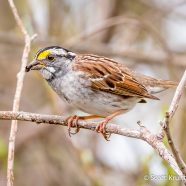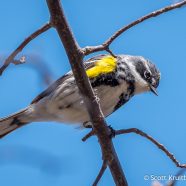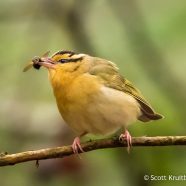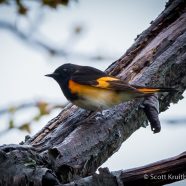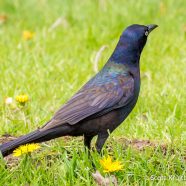White-throated Sparrow
I recently caught this White-throated Sparrow (Zonotrichia albicollis) in the middle of a meal… …which it seemed to try to hide from me until gulping it down. Their whites and yellows are much bolder right now than those that winter with us as they conclude their spring migration. In some cases you may have White-throated Sparrows year-round with some birds that overwinter at your house and head far north into Canada for the breeding season while other individuals move in to our area from even further south and nest relatively close to us in New York, Pennsylvania, and...
Read MoreYellow-rumped Warbler
Here are a couple more stunning Yellow-rumped Warbler photos while they are looking so fantastic in their spring shades – and right before all the leaves pop out. They’ll be heading out soon as a greater diversity of warblers arrive in our backyards. I did see one unique Yellow-rumped Warbler yesterday that I will feature in an upcoming post… Scott Kruitbosch Conservation & Outreach Coordinator
Read MoreWorm-eating Warbler (Helmitheros vermivorum)
I was thrilled to find and then get great views of this Worm-eating Warbler (Helmitheros vermivorum) singing and feeding earlier today. I first heard its insect-like trill of a song from along a steep, rocky slope in the forest featuring a lot of vegetation in the understory – precisely what they want for the breeding season. We in the Northeast are at the northern edge of their range, and finding the uncommon birds can be difficult. Worm-eating Warbler populations are said to be stable, but they certainly do decline and increase in certain regions depending on local conditions....
Read MoreAmerican Redstart
This is as good of a photo that I could get this morning of the adult male American Redstart (Setophaga ruticilla) seen below, and clearly I need to do better! The conditions were brutal with continued rain and some fog moving in on a very dark day, making the bird stand out even more against the drab surroundings. It was foraging and catching quite a bit while showing those bright wings and that flashy tail to help scare up insects. The weather has been uncooperative for birds as the first few days of the May migratory flight has been difficult with variable winds and precipitation making...
Read MoreCommon Grackle
This Common Grackle (Quiscalus quiscula) was in search of some snacks, using those big yellow eyes to scope out prey in the grass. They will eat nearly anything and everything which is part of why we see them everywhere in abundance. What is the strangest thing you have seen them devouring?
Read More



